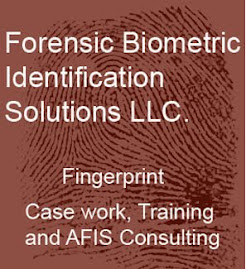I've gone over a number of issues that can contribute to bad or missed identifications. I also think that over the next few years we will probably encounter more of these missed and bad identifications. ACE-V addresses only the bad identifications and as we have seen unless the procedure can be enforced and agencies improve on proficiency and remediation programs, there will continue to be bad identifications.
So we haven't discussed missed identifications, their cause and the impact they have on a case. Every latent fingerprint examiner has had cases where the latent fingerprint entered into the automated fingerprint identification system (AFIS) did not produce the identification only to identify the latent fingerprint in a subsequent search. The target fingerprint card was in file but the system did not produce the card as a suspect on the 1st. , 2nd. or sometimes 3rd. search. Additionally there are the cases where the suspect was produced but the fingerprint examiner, for whatever reason, missed the identification. On a serious crime if the investigators have no suspects the latent fingerprint will get searched multiple times and are usually the cases that produce the identification on a 2nd. or 3rd. attempt. If, however the investigator has a strong suspect and there are unidentified latents on these cases, how often do these unidentified latents get a 2nd. or 3rd. search? Because of backlogs probably not very often.
So what are the ramifications of not improving on the missed identifications ? Hope the individual continues their criminal behavior and maybe the next criminal act we get them? From a public safety view that should be unacceptable. The next crime could result in a homicide similar to the case of Jeremy Jones in Georgia.
I'd like to see the systems create and launch multiple searches from the initial input by the latent fingerprint examiner, thus the examiner only need enter the image one time. I also think all examiners should have a good understanding of the actual accuracy of the system they are working on. The vendor will have a figure in the mid 80's for latent accuracy. These figures are developed in a controlled setting with usually 25 or more points of identification on both the search and target print. Remember even in a controlled setting the system is only hitting 80 %. Most latent examiners don't have a lot of minutiae on a latent and as I've indicated previously often the target print in the file has quality issues. The answer of course is more competently trained latent examiners and an improved search algorithm for the automated fingerprint systems.
What should be done in the interim, I would suggest is the court and/or defense attorneys have a latent expert in their employ, to evaluate the latent fingerprint evidence to insure everything was done properly.
Bob McAuley
Dir. Operations/Training
Forensic Biometric Identification Solutions LLC.
Subscribe to:
Post Comments (Atom)






1 comment:
I am visiting from a comment left on my old blog. ...new one is http://empower2go.wordpress.com I am posting your blog for my university class as it is good to get viewpoints and information from those in the field
Post a Comment